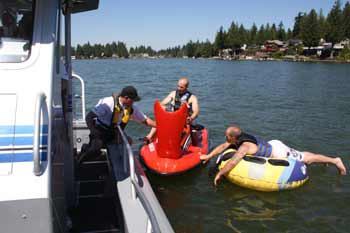Badge? Check.
Gun? Check.
Sunscreen? Check.
Because for the men and women of the Bonney Lake Police Department’s Marine Services Unit, it’s a must-have part of the uniform.
“Yeah, we use a lot of that,” said Officer Ryan Boyle on Saturday, one of the hottest and busiest days of the year so far on Lake Tapps.
And while Boyle and Officer Robert Hoag readily admit the MSU is one of the more fun beats for a city cop, the officers are serious about the business of keeping boaters, swimmers and fisherman safe on the water and it’s never as simple as it may look from the shore.
“The perception of what we do and what we really do is a little different,” said Hoag.
“The reality is we have a lot of moving parts on the lake,” Boyle said. “Our big thing is making sure everyone goes home safe in one piece.”
CLICK HERE TO SEE A SLIDESHOW FROM A DAY WITH THE MSU.
The Bonney Lake Police Marine Services Unit patrols Lake Tapps during the summer. The police boat is parked at the Allan Yorke Park boat launch and on warm, sunny weekends, police staff the boat launch and the lake.
The shifts are overtime, paid through a State Parks Department Grant, and Boyle said it is a sought-after assignment in the department.
Boyle, for example, grew up on the lake and relishes the opportunity to get out on the water even transferred from Buckley to Bonney Lake partially because of the opportunity provided by the boat.
Officers in the unit take a yearly week-long Marine School course on the Columbia River, learning water techniques and how to handle the boat, which is very different from a typical police cruiser.
“It’s kind of like an abbreviated academy,” Hoag said as he steered the police boat around one of the many shallow-water obstacles that dot Lake Tapps.
Saturday, like most days for the MSU, began at 11 a.m. checking boats as they prepared to launch at Allan Yorke Park’s boat launch. The officers spent two hours on land, making sure boaters had all of the state requirements – life preservers, fire extinguishers, horn, flags, boater education card, etc. – before they even hit the water, something Boyle said helps insure those on the lake have what they need even before they begin.
Several boaters were allowed to launch their boats, but were required to run back to Walmart or Target for a life jacket or, most often, a fire extinguisher, while someone waited with the boat.
“Out there we give them a ticket,” Boyle said, pointing to the water.
Once the boat is launched, the police spend most of their time simply being visible. Boaters tend to be more careful when the see the distinctive, silver police boat crossing the waves and nearly everyone waves from their boats, skis and inner tubes as they pass.
“We do a lot of waving,” Boyle said with a smile.
But it’s not the only thing they do.
“We’re keeping our eyes open for anything safety-wise,” Boyle said, scanning the water for boats and skiers.
While on the water Saturday afternoon, the police received a call from dispatch. A fellow boater had observed a man on a personal water craft towing another man on an inner tube without a spotter or a flag and worried about the safety of the tuber, calling the police.
Hoag turned the wheel toward the south and 21-foot aluminum boat decked out with the Bonney Lake Police Department logo headed back toward the old Church Lake section of Tapps where Boyle spotted the jet-skier in question.
The officers pulled along side the boaters and asked him to tow in his tuber and hang on to the police boat.
What followed look much like a standard traffic stop, only a little wetter as police explained why they had been called and proceeded to run through a quick inspection.
The lack of spotter and flag, they explained made it dangerous for the passenger. If the rider fell, the driver would have no way of knowing without a spotter and without a flag, other boaters would not know there was a person in the water, creating potential dangerous situations.
The two boaters nodded.
“You know,” one said, “that makes sense.”
However, neither one of the operators had a boater registration card – required this year for all operators younger than 40 – and while only giving a warning for the flag and spotter, the officers did write a ticket for the lack of card, but explained that the fine could be waived if the owner took the course online and provided proof to a judge within 30 days.
The jet skiers headed back to the land to take the online course and get a flag and planned to be back on the water that afternoon.
Boyle said the incident was fairly typical of the five or six stops per day the police makes.
“They got a ticket for what caused them not to know,” Boyle said about the warnings from the flag and spotter. “Now they’re going to get educated.
“If you look at all the accidents we’ve ever had … it’s the lack of knowledge going on,” he said.
As the boat moved slowly back toward its dock, Hoag and Boyle spotted a swimmer well outside the marked swimming area, headed back toward the shore and slowly inched int hat direction, just in case. Fortunately, he made his way back among the buoys without problem and the police boat floated slowly back toward the dock as the officers smiled and chatted with swimmers on the other side of the buoys, making sure the swimmers knew the dangers of the Lake Tapps, which is colder and deeper than many lakes and has so far this year claimed three lives.
The swimmers nodded and waved back, thanking the police for the tips.
“It’s all about education” Boyle said.



